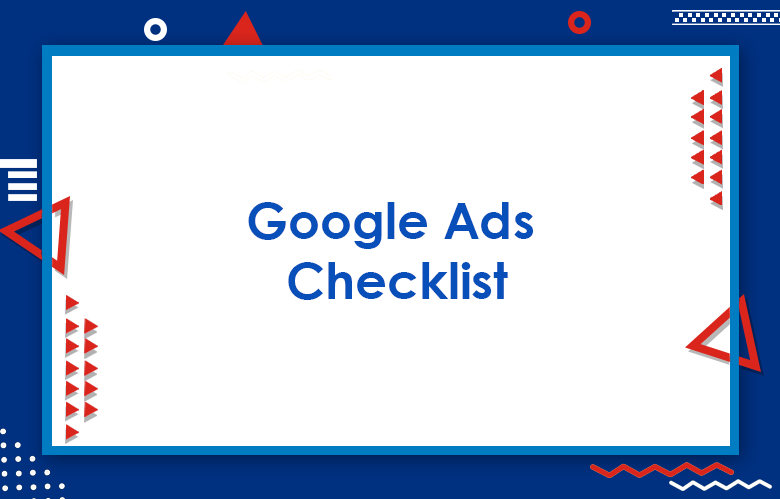Google Ads Checklist: The Ultimate Guide to Google Ads

Google Ads Checklist: Launching Google Ads campaigns is the primary step we all follow to build up the business. Also, managing and monitoring ad campaigns can help you find the right things at the right time.
This can be used to scale the performance of your business growth. Simultaneously, Goo and glue Ads are the most challenging tasks for businesses.
How can you bang Google Ads? This is possible with tips and strategies. Google is the only search engine with the most engaging platform for giant social media channels.
You can find the Google Ads checklist here to help you launch effective ad campaigns.
Five tips and tricks to set up a compelling account in 5 minutes or less
Checklist:
-Define your audience
-Create a unique landing page
-Build targeted campaigns
-Set up conversion tracking
-Establish billing properly
Over the next five years, every small business will grow with Google ads
1: Get an ad set up for a keyword you’re targeting
2: Build a squeeze page with your email opt-in and blog URL
3: Share the ad on social and see if you can get any signups
4: A/B test 3 different CTA’s (download, newsletter signup, and video demo)
Google Ads are 80% CRITICAL
1: You need to use CRITICAL Keywords in your ad
2: Your ad needs a STRONG Headline
3: You need a clear & strong CTA
4: Your copy needs to be engaging and witty. (if possible)
5: Test at least three ads. One might get you the click.
Are you wondering if Google Ads is even suitable for your small business?
Boost your ad and reach out to new audiences
1: Learn how successful brands are advertising on Google Ads
2: Tips to making your AdWords campaigns a success
3: Don’t use all the extras; they’ll just cost you money
Are you doing the five most important things to increase your Google Ad ROI?
1: Image and copy consistency
2: Showing up on brand keyword searches
3: Relevant hashtags
4: Posting at optimum times
5: Proper engagement (CTAs)
See the Google Ads checklist before you start
1: Find new audiences
2: Track conversions
3: Target your content
4: Create a layered ad stack
5: Use Google AMP to save time and money
Are you advertising through Google Ads?
1: Have you managed your campaign correctly?
2: Did you set up your goals correctly?
3: Are you bidding in the right place?
Google Ads Checklist
Find the ad extensions that are required:
The ad extensions let the audience directly take action from the search results by offering additional information.
Bid changes:
The bid adjustment enables the businesses to display the ad campaigns depending on when, where, and how the audience searches.
Ad rotation:
It is the process of displaying multiple ad campaigns in a specific location on the business web page. In this method, the ad campaigns are rotated with each new web page load within the loading of a single page.
Ad scheduling:
Perfect timing is everything for all ad campaigns to alert the audience to watch your advertisement; this can be done through the ad scheduling strategy.
Destination URLs:
When the audience clicks on your business’s ad campaigns, they are directed to the website, which includes the destination URL.
Review the settings of the ad campaign keyword match type:
Knowing the keyword match types can let your ad campaign be delivered by matching the keywords to the audience search query.
Time of day:
The exact time of the day to launch the ad campaign holds continuous audience engagement by attaining attention.
Daily budget:
Properly evaluating the daily ad campaign budget is necessary to launch the campaigns within an affordable budget.
Locations and languages:
Deliver the ad campaign by targeting the location and languages of the audience that you want to reach.
Negative keyword list:
Get the negative keyword list that lowers the ad campaign performance and boosts your campaign reach.
Set up the ad campaign plan:
Before delivering the ad campaign, make sure to sketch the perfect plan for the campaign to find more engagement.
Have the campaign structure:
Outlining the ad campaign structure can let you add more content with the optimization strategies.
Get the top-performing keywords for the ad campaign:
Trace the list of top-performing keywords that make your campaign trend by attaining a more significant number of audiences.
Create the first ad campaign copy:
Creating the ad campaign copy can help you improve the conversion rates and increase the traffic to the website.
Analyzing the historical performance:
Knowing the performance of past ad campaigns can let you add more valuable content to the upcoming advertisements.
Creating an AdWords account:
Creating a Google AdWords account is the primary step that all businesses must consider before launching an ad campaign.
Review the Display network:
Reviewing the Display network can help businesses reflect and enhance ad campaign success.
Conversion tracking:
It is essential to track the conversions properly and target the right audience with relevant advertising strategies.
Campaigns enabled for ad group:
Trace the count of ad campaigns enabled for each ad group. Using multiple ad groups as a strategy, one can build ads targeting specific keywords.
Check budgets:
Plan, track, and enhance the budget-making strategies by monitoring the ad campaign.
Pause the poor campaign:
Try to pause the lower-performing ad campaign keywords and boost the number of clicks you want.
Add the negative keywords:
The addition of negative keywords can let you implement better ad campaigns that find business growth.
Expand the keyword research:
Research on getting the list of top audience reaches keywords to enhance brand engagement.
Reviewing the ad campaigns is necessary:
Before running the ad campaign, review adding the required features and content.
Analyze the landing page:
Make sure to analyze the landing page of your business website to hold visitor engagement through the generation of ad campaigns.
Devices:
Deliver your ad campaign by targeting the most used devices vital to producing website traffic over your advertisement.
AdRank:
Identifying the ad rank of your business ad campaign can let you find more advertising methods by hiring advanced tools.
Quality Score (QS):
The quality score of the advertisement, which can have more chances to gain popularity from competitors, is essential.
Reporting & the Action Plan:
Make sure to define your business tasks, the target of individuals, and budget cost, and monitor the ad campaign progress to find better results with fewer efforts.
Conclusion:
The lack of preparation for changes in the ad campaigns may lead to a decrease in the business’s performance. Optimizing the ad campaigns can give your business a competitive edge; therefore, you should know the best practices for optimizing the ad campaigns. The Google Ads checklist listed below is the best way to keep track of your ad campaigns.
Call: +91 9848321284
Email: [email protected]



